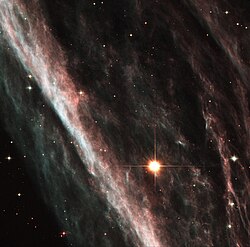astro.wikisort.org - Galaxy
NGC 2736 (also known as the Pencil Nebula) is a small part of the Vela Supernova Remnant, located near the Vela Pulsar in the constellation Vela. The nebula's linear appearance triggered its popular name. It resides about 815 light-years (250 parsecs) away from the Solar System. It is thought to be formed from part of the shock wave of the larger Vela Supernova Remnant. The Pencil Nebula is moving at roughly 644,000 kilometers per hour (400,000 miles per hour).
| Nebula | |
|---|---|
 HST picture of NGC 2736 | |
| Observation data: J2000 epoch | |
| Right ascension | 9h 0m 17s[1] |
| Declination | −45° 54′ 57″[1] |
| Distance | 815 ly |
| Apparent magnitude (V) | +12.0? |
| Apparent dimensions (V) | 30'x7' |
| Constellation | Vela[2] |
| Physical characteristics | |
| Radius | ~5.0 ly |
| Designations | NGC 2736, Pencil Nebula |
History

On 1 March 1835, John Herschel discovered this object at the Cape of Good Hope and described it as "eeF, L, vvmE; an extraordinary long narrow ray of excessively feeble light; position 19 ±. At least 20' long, extending much beyond the limits of the field...". This agrees perfectly with the ESO- Uppsala listing N2736 = E260-N14, a nebula with dimensions 30'x7', position angle of 20 and notes "Luminous filament". Harold Corwin adds that on the ESO IIIa-F film this nebula is the brightest patch of a huge supernova remnant (Gum Nebula) whose delicate whisps cover the field. A relatively bright star is immersed in N2736 (mentioned by Herschel).[3]
References
- "NASA/IPAC EXTRAGALACTIC DATABASE". Results for NGC 2736. Retrieved 2007-04-03.
- "Hubble Heritage Site". Results for NGC 2736. Retrieved 2007-04-03.
- Steve Gottlieb. "CORRECTIONS TO THE RNGC:5". Archived from the original on 1999-10-12. Retrieved 2018-08-13.
External links
На других языках
[de] Bleistiftnebel
NGC 2736, manchmal auch Bleistiftnebel genannt, ist ein Emissionsnebel im Sternbild Vela, welcher 815 Lichtjahre von der Erde entfernt ist. NGC 2736 ist der Überrest einer gewaltigen Explosion einer Supernova vor etwa 11.000 Jahren. Diese Supernova wird die Vela-Supernova genannt. Zu Beginn der Explosion soll sie 250 mal heller geleuchtet haben als die Venus und sich mit einer Geschwindigkeit von 40 Millionen Kilometern pro Stunde ausgedehnt haben. Die Geschwindigkeit hat sich bis heute auf 640.000 Kilometern pro Stunde verlangsamt. Diese Sternenexplosion hinterließ einen Pulsar, der im Jahr 1968 entdeckt und später auch optisch identifiziert wurde, seine Rotationsperiode beträgt 89 Millisekunden.[3]- [en] NGC 2736
[ru] NGC 2736
NGC 2736 (другое обозначение — ESO 260-N14) — эмиссионная туманность в созвездии Паруса. Является небольшой частью остатка сверхновой в Парусах, расположена вблизи пульсара в Парусах. Из-за вытянутой формы туманность иногда называют Туманность Карандаш (англ. Pencil Nebula). Находится на расстоянии около 250 парсеков от Солнца. Считается, что туманность образовалась под действием ударной волны как часть более крупного остатка сверхновой в Парусах. Туманность движется со скоростью около 644 тысяч км/ч относительно Солнечной системы.Другой контент может иметь иную лицензию. Перед использованием материалов сайта WikiSort.org внимательно изучите правила лицензирования конкретных элементов наполнения сайта.
WikiSort.org - проект по пересортировке и дополнению контента Википедии